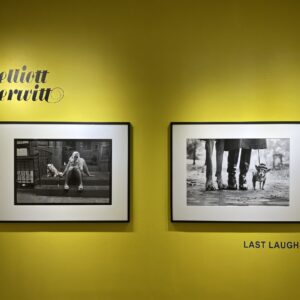JTF (just the facts): A total of 8 photographic works, framed in wood and unmatted, and hung against white walls in the two room gallery space. All of the works are photogravures, made in 2020. Each is sized roughly 31×35 inches, and is available in an edition of 8+2AP. (Installation shots below.)
Comments/Context: When photographers start to have confidence in their control of how certain technical choices and techniques will manifest themselves in visual outcomes, they become much more able to pre-emptively match an approach with a desired result. Rodrigo Valenzuela’s new works take the form of photogravures – where photographic images are transferred to copper plate and printed like an etching – and this less-than-obvious process choice was a direct result of wanting to give the prints an overtly tactile, almost dusty feel.
In the past decade, Valenzuela has been methodically working through different in-studio construction and image making approaches. He’s made photographs in both black and white and color, at small and large scale, with alternate materials and lighting, and with varying echoes of his previous life in Chile. In recent gallery shows (in 2018 reviewed here, and 2019 reviewed here), he has used disorienting rephotography to explore the AbEx aesthetics of Franz Kline, recreated whitewashed motifs drawn from protest barricades, and transformed ordinary construction materials like two-by-fours and concrete blocks into evocative shrines.
Valenzuela’s recent works largely leave the illusionism behind and instead center in on textures and muted tonalities. Each of his studio setups has been constructed in what looks like a old storage locker or a musty Egyptian tomb – three squared-off sides close in, creating a confined space for sculptural improvisation. For the most part, his forms are built from casts of polystyrene molds, like the kind that protect fragile things when packed into a shipping box. Valenzuela has repurposed these curved and indented non-objects, layering them into dense piles, towers, and precariously-balanced agglomerations.
While there is symbolism and allusion to be found in Valenzuela’s curves and geometries – consumerism (in a manner similar to Sara Cwynar’s tabletop constructions in plastic), Brutalist concrete architecture, industrialized Modernism, even what looks to be the cast shadow of a horse’s head – these works feel more rooted in surfaces and physical presence than in any hidden meanings. Many shimmer in subtle shades of grey and silver, with the matte surface of the paper giving the textures an even more gritty feel. Valenzuela’s use of light also enhances these nuanced moods – light blasts in from the front, whitewashing front-facing facets and throwing shadows on the back wall; is used as a spotlight, creating more obscure tunnels of attention; or drops from the ceiling, casting dark forms down to the floor. Each of these approaches leads to a different set of highlights, tonalities, and visual echoes, the objects transformed into dramatic totems and inexplicable structures that emerge from the enveloping dust. As we look longer, we settle into their serene worn edges and mottled sides, their physicality implying both muscular labor and unmeasurable age.
Much of the resonance in these images comes from the way Valenzuela has employed the photogravure process. These aren’t throwback or mannered old timey aesthetic decisions he’s made; instead, he’s smartly leveraged the strengths of the process to deliver the kind of surface qualities he needed. The pictures do have an almost ancient quality, even though they are resolutely contemporary, and it’s this seductive friction that keeps us thinking. For the first time, he has deliberately introduced the variable of time into his works, encouraging us to see his elemental forms against a broader sweep of potential history.
Collector’s POV: The prints in this show are priced at $6000 each. Valenzuela’s work has little secondary market history at this point, so gallery retail likely remains the best option for those collectors interested in following up.










